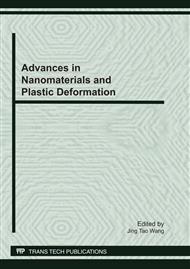[1]
R. Z. Valiev, R. K. Islamgaliev and I. V. Alexandrov: Prog. Mater. Sci. Vol. 45 (2000), p.103.
Google Scholar
[2]
R. Z. Valiev, T. G. Langdon: Prog. Mater. Sci. Vol. 51 (2006), p.881.
Google Scholar
[3]
H. Jiang, Y. T. Zhu, D. P. Butt, T. C. Lowe and R. Z. Valiev: Mater. Sci. Eng. Vol. A290 (2000), p.128.
Google Scholar
[4]
A .P. Zhilyaev, G. V. Nurislamova, B. K. Kim, M. D. Baró, J. A. Szpunar and T. G. Langdon: Acta Mater. Vol. 51 (2003), p.753.
DOI: 10.1016/s1359-6454(02)00466-4
Google Scholar
[5]
Y. Saito, N. Tsuji, H. Utsunomiya, T. Sakai and R.G. Hong. Scripta Mater. Vol. 39 (1998), p.1221.
Google Scholar
[6]
M Eizadjou, H. D. Manesh and K. Janghorban: Journal of Alloys and Compounds Vol. 474 (2009), p.406.
Google Scholar
[7]
J. Y. Huang, Y. T. Zhu, H. Jiang and T. C. Lowe: Acta Mater. Vol. 49 (2001), p.1497.
Google Scholar
[8]
J.Y. Huang, Y.T. Zhu, H. Jiang and T.C. Lowe: Metal. Mater. Trans. Vol. 32A (2001), p.1559.
Google Scholar
[9]
C. C. Koch: Nanostruct. Mater. Vol. 9 (1997), p.13.
Google Scholar
[10]
A. P. Zhilyaev, B. K. Kim, J. A. Szpunar, M. D. Baró and T. G. Langdon: Mater. Sci. Eng. Vol. A391 (2005), p.377.
Google Scholar
[11]
Y. H. Zhao, X. Z. Liao, Y. T. Zhu, Z. Horita and T. G. Langdon: Mater. Sci. Eng. Vol. A 410-411(2005), p.188.
Google Scholar
[12]
S. D. Terhune, D. L. Swisher, K. O. Ishi, Z. Horita and T. G. Langdon: T. R. McNelley, Metal. Mater. Tran. Vol. 33A (2002), p.2173.
Google Scholar
[13]
M. Reihanian, R. Ebrahimi, M. M. Moshiksar, D. Terada and N. Tsuji: Materials Characterization Vol. 59 (2008), p.1312.
Google Scholar
[14]
F. H. D. Torre, E. V. Pereloma and C. H. J. Davies: Acta Mater. Vol. 4 (2006), p.1135.
Google Scholar
[15]
F. D. Torre, R. Lapovok, J. Sandlin, P. F. Thomson, C. H. J. Davies and E. V. Pereloma: Acta Mater. Vol. 52 (2004), p.4819.
Google Scholar
[16]
A. P. Zhilyaev, B. K. Kim, J. A. Szpunar, M. D. Baró and T. G. Langdon: Mater. Sci. Eng. Vol. A 391 (2005), p.377.
Google Scholar
[17]
S. Qu, X. H. An, H.J. Yang, C. X. Huang, G. Yang, Q. S. Zang, Z. G. Wang, S. D. Wu, Z. F. Zhang: Acta Mater. Vol. 57 (2009), p.1586.
Google Scholar
[18]
F.A. Mohamed: Acta Mater. Vol. 51 (2003), p.4107.
Google Scholar
[19]
K. Lu, L. Lu, S. Suresh: Science 324 (2009), p.349.
Google Scholar
[20]
X. Z. Liao, Y. H. Zhao, S. G. Srinivasan, Y. T. Zhu, R. Z. Valiev and D. V. Gunderov: Appl. Phys. Lett. Vol. 84 (2004), p.592.
Google Scholar
[21]
D. A. Hughes, N. Hansen: ASM International, Materials Park, OH, 2004, p.192.
Google Scholar
[22]
L. Chen, Q. Shi, D. Chen, S. Zhou, J. Wang and X. Luo: Mater. Sci. Eng. Vol. A 508 (2009), p.37.
Google Scholar
[23]
M. Shaarbaf, M. R. Toroghinejad: Mater. Sci. Eng. Vol. A 473 (2008), p.28.
Google Scholar
[24]
L. Kommel, I. Hussainova and O. Volobueva: Materials & Design Vol. 28 (2007), p.2121.
Google Scholar
[25]
X. Molodova, G. Gottstein, M. Winning and R. J. Hellmig: Mater. Sci. Eng. Vol. A 460-461 (2007), p.204.
Google Scholar
[26]
N. Lugo, N. Llorca, J.M. Cabrera and Z. Horita: Mater. Sci. Eng. Vol. A 477 (2008), p.366.
Google Scholar
[27]
Y. Zhang, J. T. Wang, C. Cheng and J. Q. Liu: J. Mater. Sci. Vol. 43 (2008), p.7326.
Google Scholar
[28]
R. Kaibyshev, K. Shipilova, F. Musin, Y. Motohashi: Mater. Sci. Eng. Vol. A 396 (2005), p.341.
Google Scholar
[29]
O. Sitdikov, T. Sakai, E. Avtokratova, R. Kaibyshev, K. Tsuzaki, Y. Watanabe: Acta Mater. Vol. 56 (2008), p.821.
DOI: 10.1016/j.actamat.2007.10.029
Google Scholar
[30]
T. Sakai, H. Miura, A. Goloborodko, O. Sitdikov: Acta Mater. Vol. 57 (2009), p.153.
Google Scholar
[31]
J.T. Wang, Y. Zhang. J.Q. Liu: Mater. Sci. Forum Vol. 584-586 (2008), p.929.
Google Scholar
[32]
W.H. Huang, C.Y. Yu, P.W. Kao and C.P. Chang: Mater. Sci. Eng. Vol. A366 (2004), p.221.
Google Scholar
[33]
A.M. Cuitino: Mater. Sci. Eng. Vol 216 (1996), p.104.
Google Scholar


